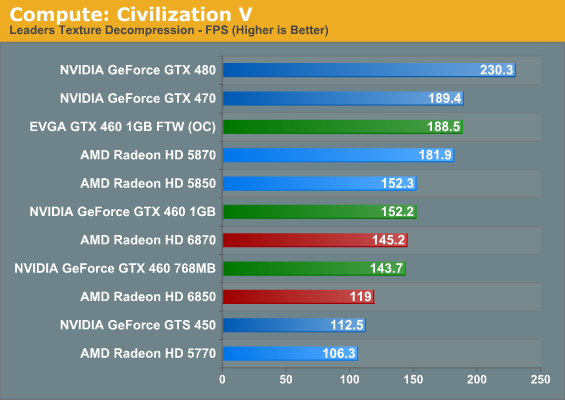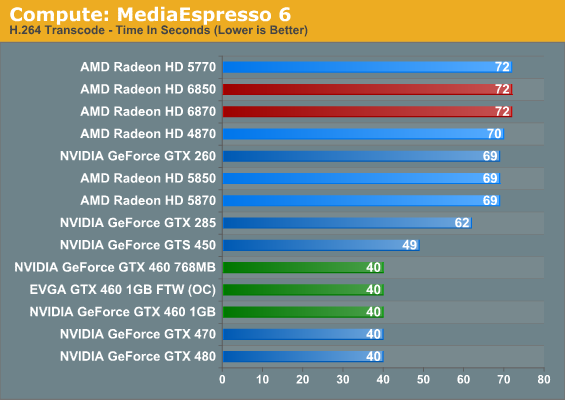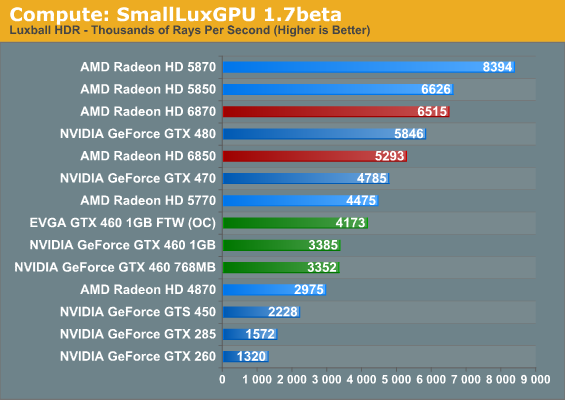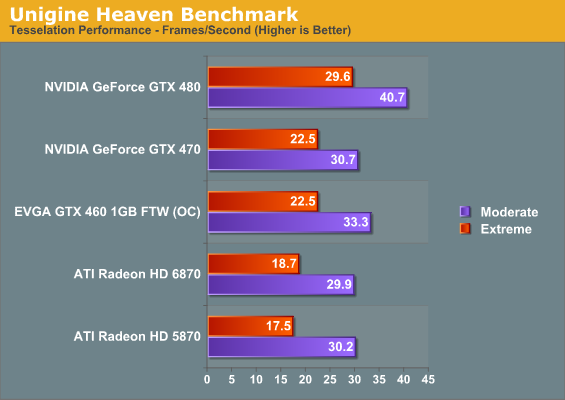AMD’s Radeon HD 6870 & 6850: Renewing Competition in the Mid-Range Market
by Ryan Smith on October 21, 2010 10:08 PM ESTFor a while now we’ve been trying to establish a proper cross-platform compute benchmark suite to add to our GPU articles. It’s not been entirely successful.
While GPUs have been compute capable in some form since 2006 with the launch of G80, and AMD significantly improved their compute capabilities in 2009 with Cypress, the software has been slow to catch on. From gatherings such as NVIDIA’s GTC we’ve seen first-hand how GPU computing is being used in the high-performance computing market, but the consumer side hasn’t materialized as quickly as the right situations for using GPU computing aren’t as straightforward and many developers are unwilling to attach themselves to a single platform in the process.
2009 saw the ratification of OpenCL 1.0 and the launch of DirectCompute, and while the launch of these cross-platform APIs removed some of the roadblocks, we heard as recently as last month from Adobe and others that there’s still work to be done before companies can confidently deploy GPU compute accelerated software. The immaturity of OpenCL drivers was cited as one cause, however there’s also the fact that a lot of computers simply don’t have a suitable compute-capable GPU – it’s Intel that’s the world’s biggest GPU vendor after all.
So here in the fall of 2010 our search for a wide variety of GPU compute applications hasn’t panned out quite like we expected it too. Widespread adoption of GPU computing in consumer applications is still around the corner, so for the time being we have to get creative.
With that in mind we’ve gone ahead and cooked up a new GPU compute benchmark suite based on the software available to us. On the consumer side we have the latest version of Cyberlink’s MediaEspresso video encoding suite and an interesting sub-benchmark from Civilization V. On the professional side we have SmallLuxGPU, an OpenCL based ray tracer. We don’t expect this to be the be all and end all of GPU computing benchmarks, but it gives us a place to start and allows us to cover both cross-platform APIs and NVIDIA & AMD’s platform-specific APIs.
Our first compute benchmark comes from Civilization V, which uses DirectCompute to decompress textures on the fly. Civ V includes a sub-benchmark that exclusively tests the speed of their texture decompression algorithm by repeatedly decompressing the textures required for one of the game’s leader scenes.

In our look at Civ V’s performance as a game, we noted that it favors NVIDIA’s GPUs at the moment, and this may be part of the reason why. NVIDIA’s GPUs clean up here, particularly when compared to the 6800 series and its reduced shader count. Furthermore within the GPU families the results are very straightforward, with the order following the relative compute power of each GPU. To be fair to AMD they made a conscious decision to not chase GPU computing performance with the 6800 series, but as a result it fares poorly here.
Our second compute benchmark is Cyberlink’s MediaEspresso 6, the latest version of their GPU-accelerated video encoding suite. MediaEspresso 6 doesn’t currently utilize a common API, and instead has codepaths for both AMD’s APP (née Stream) and NVIDIA’s CUDA APIs, which gives us a chance to test each API with a common program bridging them. As we’ll see this doesn’t necessarily mean that MediaEspresso behaves similarly on both AMD and NVIDIA GPUs, but for MediaEspresso users it is what it is.

We decided to go ahead and use MediaEspresso in this article not knowing what we’d find, and it turns out the results were both more and less than we were expecting at the same time. While our charts don’t show it, video transcoding isn’t all that GPU intensive with MediaEspresso; once we achieve a certain threshold of compute performance on a GPU – such as a GTX 460 in the case of an NVIDIA card – the rest of the process is CPU bottlenecked. As a result all of our Fermi NVIDIA cards at the GTX 460 or better take just as long to encode our sample video, and while the AMD cards show some stratification, it’s on the order of only a couple of seconds. From this it’s clear that with Cyberlink’s technology having a GPU is going to help, but it can’t completely offload what’s historically been a CPU-intensive activity.
As for an AMD/NVIDIA cross comparison, the results are straightforward but not particularly enlightening. It turns out that MediaEspresso 6 is significantly faster on NVIDIA GPUs than it is on AMD GPUs, but since we’ve already established that MediaEspresso 6 is CPU limited when using these powerful GPUs, it doesn’t say anything about the hardware. AMD and NVIDIA both provide common GPU video encoding frameworks for their products that Cyberlink taps in to, and it’s here where we believe the difference lies.
In particular we see MediaEspresso 6 achieve 50% CPU utilization (4 core) when being used with an NVIDIA GPU, while it only achieves 13% CPU utilization (1 core) with an AMD GPU. At this point it would appear that the CPU portions of NVIDIA’s GPU encoding framework are multithreaded while AMD’s framework is singlethreaded. And since the performance bottleneck for video encoding still lies with the CPU, this would be why the NVIDIA GPUs do so much better than the AMD GPUs in this benchmark.
Our final GPU compute benchmark is SmallLuxGPU, the GPU ray tracing branch of the open source LuxRender renderer. While it’s still in beta, SmallLuxGPU recently hit a milestone by implementing a complete ray tracing engine in OpenCL, allowing them to fully offload the process to the GPU. It’s this ray tracing engine we’re testing.

Compared to our other two GPU computing benchmarks, SmallLuxGPU follows the theoretical performance of our GPUs much more closely. As a result our Radeon GPUs with their difficult-to-utilize VLIW5 design end up topping the charts by a significant margin, while the fastest comparable NVIDIA GPU is still 10% slower than the 6850. Ultimately what we’re looking at is what amounts to the best-case scenarios for these GPUs, with this being as good an example as any that in the right circumstances AMD’s VLIW5 shader design can go toe-to-toe with NVIDIA’s compute-focused design and still win.
At the other end of the spectrum from GPU computing performance is GPU tessellation performance, used exclusively for graphical purposes. For the Radeon 6800 series, AMD enhanced their tessellation unit to offer better tessellation performance at lower tessellation factors. In order to analyze the performance of AMD’s enhanced tessellator, we’re using the Unigine Heaven benchmark and Microsoft’s DirectX 11 Detail Tessellation sample program to measure the tessellation performance of a few of our cards.

Since Heaven is a synthetic benchmark at the moment (the DX11 engine isn’t currently used in any games) we’re less concerned with performance relative to NVIDIA’s cards and more concerned with performance relative to the 5870. Compared to the 5870 the 6870 ends up being slightly slower when using moderate amounts of tessellation, while it pulls ahead when using extreme amounts of tessellation. Considering that the 6870 is around 7% slower in games than the 5870 this is actually quite an accomplishment for Barts, and one that we can easily trace back to AMD’s tessellator improvements.

Our second tessellation test is Microsoft’s DirectX 11 Detail Tessellation sample program, which is a much more straightforward test of tessellation performance. Here we’re simply looking at the framerate of the program at different tessellation levels, specifically level 7 (the default level) and level 11 (the maximum level). Here AMD’s tessellation improvements become even more apparent, with the 6870 handily beating the 5870. In fact our results are very close to AMD’s own internal results – at level 7 the 6870 is 43% faster than the 5870, while at level 11 that improvement drops to 29% as the increased level leads to an increasingly large tessellation factor. However this also highlights the fact that AMD’s tessellation performance still collapses at high factors compared to NVIDIA’s GPUs, making it all the more important for AMD to encourage developers to use more reasonable tessellation factors.










197 Comments
View All Comments
GullLars - Saturday, October 23, 2010 - link
One sollution would be to to move away from pure number based naming, and do something like:AMD/nVidia AG#S# ([Maker]_[Architecture][Generation][# generation of architecture][Market Segment][# of relative performance within segment 1-9]
Or possibly AMD/Nvidia Architecture Gen# S#
Example:
AMD EG1E9 or Evergreen Gen1 E9 = 5970 (Enthusiast)
nVidia FG1E9 = 480
AMD Evergreen Gen2 G5(?) = 6850 (Gamer)
AMD Evergreen Gen1 V7 = 5770 (Value)
AMD Evergreen Gen1 M5 = 5350 (Media)
These are just early floating thoughts, which could be refined by marketing monkeys.
Exelius - Saturday, October 23, 2010 - link
Marketing monkeys have no intent on making it simple to understand; if you don't know exactly what you're buying, it's easier to sell it to you for more than they would be able to otherwise.It's not an accident that the numbering is confusing; if you don't know what you're looking at then a 6870 at a lower price than a 5870 looks like a great deal.
MonkeyPaw - Friday, October 22, 2010 - link
Big deal, I say. The card is a few % slower, but is more efficient and is cheaper. People who will actually notice the drop off will probably read reviews first. Besides, if the x900 series is for dual GPU designs, then the naming might not be far off.Also, if I had to pick between the 5800 or the 6800, I'd probably get a 6800.
therealnickdanger - Friday, October 22, 2010 - link
Don't forget improved image quality!It's only disappointing because with a new moniker, I expect new tech, but then again, how long did NVIDIA push G92? 3 generations as different products? LOL
Rafterman - Friday, October 22, 2010 - link
What exactly have NVidia got to do with this, no fanboyism please.morphologia - Friday, October 22, 2010 - link
They are a comparable company with comparably ridiculous naming conventions. How do you go from 9000 to 200?Talk about fanboyism...claiming irrelevancy when it's totally relevant reveals your fanboy decoder ring quite clearly.
Alilsneaky - Friday, October 22, 2010 - link
I hated nvidia for doing it, why should amd now be forgiven for resorting to doing the same bullshit just because nvidia did it before them?I had someone tell me earlier 'that's business'.
WHAT? No it's bloody not, a scam is a scam, when people start equalling questionable practices like these to business then something is really wrong with today's society.
Mr Perfect - Friday, October 22, 2010 - link
What Nvidia did was simply rename the 8800 cards to 9800 card. Same exact chip, same exact clocks, same exact board(at least initially). There where owners of 8800GTs who simply edited the name in the BIOS of their card and had a 9800GT!The reason AMD is getting a pass from most people is because this isn't a purely renamed card. It's a redesigned chip on a new PCB with a poor name. If, on the other hand, AMD renames the 5750 and 5770 to the 6750 and 6770 you can expect them to get nailed to the wall right next to Nvidia.
pcfxer - Saturday, October 23, 2010 - link
It was very clear why he mentioned NVIDIA. You should read his post...snarfbot - Friday, October 22, 2010 - link
at least all the iterations of g92 improved performance over their predecessor.compare this launch to the x1xxx series of ati products, the x1800 was replaced by the x1900 which was replaced by the x1950. all of which improved performance over their predecessor. all the while on the same process 90nm.(save for the 1950pro and gt, which were mainstream parts.)
imagine if they named the x1900 the x2900, and somehow it actually performed worse than the x1800.
thats what they did here, and thats why it fails imo.
if they just called it hd5790 and kept it at the same price people wouldve gobbled it up anyway, without sacrificing their integrity.
just a bunch of numbers, but what it means in mindshare is important, and all most people will remember about this generation, is that it was worse than the 5 series and worse than nvidias.
all aboard the fail boat. honk honk.